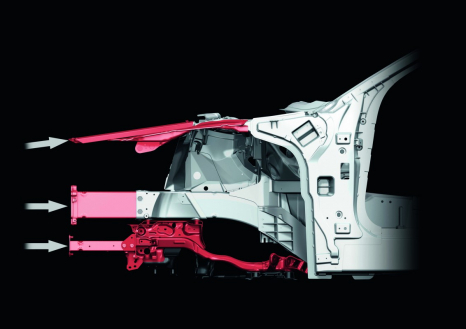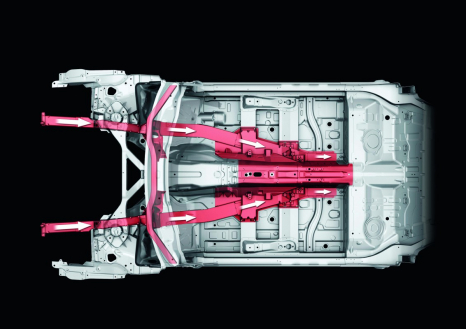Crash safety
In every development process, crash safety is of utmost priority for Audi. Each new model must comply not only with European standards, but also with the regulations of major export countries as well as strict specifications that the brand itself has defined.
Take the A8; Combined CO2-emissions in g/km: 264 – 144)** with its aluminum body, for example. The longitudinal members in the front section of the car are composed of extruded sections and extremely strong castings. In a front-end collision, the forces are absorbed by four load paths on each side of the vehicle. Two of these are found in the upper region of the fenders, and the others are located in the longitudinal members and the buffers situated in front of the subframe for the engine and front axle. The other party involved in the accident also benefits from the homogeneous design of the A8 front.
A curved, omega-shaped cross-member fabricated from a double box section provides additional protection for the passenger cell. The member is positioned at the level of the footwells. It directs the forces into the floor and the A-pillars. In the floor panel, the longitudinal members converge in a V-shape beneath the rear seat bench. In combination with the center tunnel, they form the body’s strong intersecting point.
In a side impact, the extremely high-tensile-strength steel B-pillars stand at the ready. They transmit a portion of the forces onto the strong roof frame. The side sills and the cross-members in the floor between them perform the bulk of the deformation work. The doors with their integrated impact sections assist them in this capacity. Their edges overlap large areas of the columns, sills and roof frame, allowing these components to act as a brace.
Generously sized frame elements in the tail end protect the passenger cell. In an impact, the side sills lend support to the rear wheels. Following an accident, the control unit unlocks all of the doors. At the same time, the current line between the battery, starter and alternator is disconnected. However, the power supply to essential components such as the restraint system, the hazard warning system and the door electrics remains active.
**Figures depend on the tires/wheels used.
Status: 2011

